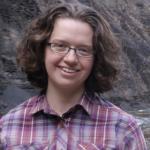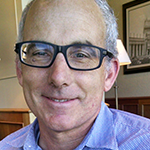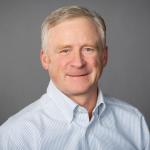Remote teaching collaboration on mapping active faults for probabilistic fault displacement hazard
For the Fall 2020 semester, Arizona State University and the University of Nevada-Reno jointly offered a new remote course on "Mapping tectonic faults from geomorphology". Ten undergraduate and graduate students from both universities enrolled to learn how to use professional fault zone mapping techniques to document features along faults prior to recent earthquakes. Chelsea Scott (ASU), Ramón Arrowsmith (ASU) and Rich Koehler (UNR) worked with the students to map and identify fault traces and deformation zones active in the recent past, taking the first step in answering "What is the fault rupture hazard near active faults?"
 |
| By ASU undergraduate geology student Rachel Adam: Fault zone mapping along the San Andreas Fault zone prior to the 2004 Parkfield earthquake (town of Parkfield is in the left center). Numbers indicate locations of detailed examples from her final report. |
Consistently mapping principal and secondary fault traces (with age estimates) is a basis of Probabilistic Fault Displacement Hazard Analysis (PFDHA, pronounced ”poofdah”). Industries and agencies responsible for critical infrastructure use PFDHA to assess a fault’s potential to rupture and disrupt lifelines such as water, gas, power, communication, sewer systems and transportation. Experts in this field, including Chris Madugo (PG&E), Alex Sarmiento (UCLA), Tim Dawson (California Geological Survey) and Steve Thompson (Lettis Consultants International), motivated the work, helped to instruct students in the practical applications of fault mapping techniques, and reviewed the students’ efforts.
 |
| By UNR graduate student Jenna Graham: Sparse evidence for pre 2020 Monte Cristo, Nevada, earthquake faulting (red lines). She mapped the complex alluvial fan systems, bedrock ranges, and anthropogenic features as part of the systematic effort. |
This remote teaching collaboration between ASU, UNR and industry experts resulted in one instructor for every two students enrolled. The course was not only practical, but also engaging for the students who were ultimately challenged to map (digitally) different fault zones using pre-earthquake imagery and topography (using QGIS Free and Open-Source Software for Geoinformatics; https://qgis.org). We built this website to help with the fully virtual activity.
The course started with introductory lectures and small assignments on active fault mapping (basics of morphologic and Quaternary geologic mapping as well as classic studies of different faulting environments). The students were then assigned to digitally map two different fault zones using techniques learned. We chose a range of pre-rupture fault targets in a variety of climates with different types of deformation (simple vs. complex fault geometry, rupture ends, fault types, varying maturity and slip rate). These included the 1983 Borah Peak, 1966 and 2004 Parkfield, 2010 El Mayor Cucupah, 2011 Fukushima, 2013 Balochistan, 2014 Napa, 2016 Kaikoura, 2016 Kumamoto, and 2020 Monte Cristo events.
Each student dedicated 20 hours to mapping each of the two areas assigned. Each rupture area was mapped by two students. They were tasked to consider the primary and secondary traces, to indicate uncertainty, and to not look at post rupture imagery to avoid bias. The instructors stressed the separation of observations from interpretation, and challenged the students to document their decision-making and to use the mapping and cartography of point, line and polygon features to support their final fault trace line work.
As a group, we reviewed multiple professional mapping styles from U.S. agency and industry work, as well as international examples. We worked to strike a balance between moving our mapping closer to the standards of practice without also introducing too much additional bias. The latter class meetings were devoted to status reports and feedback from the instructors, as well as other students, on the mapping.
The class provided a valuable opportunity to work with and train a motivated group of young geoscientists, who produced relatively unbiased maps at a high-quality standard. By using pre-earthquake topographic and imagery data, the students knew very little of the earthquakes that ruptured across the mapping areas.
This collaborative teaching activity is well suited to the remote requirements of the pandemic. The students (and instructors) appreciated the applied emphasis of the course, and received good feedback to further develop their mapping skills. All of us developed an appreciation for the need for formal approaches to produce objective fault zone maps. A highlight during the class meetings was the career path and guidance from the professional geologists for the students.
About the Authors
 |
Chelsea Scott is an assistant research scientist at Arizona State University where she conducts research in active tectonics, fault zone geomorphology, and remote sensing. Previously, she served as a National Science Foundation Postdoctoral Scholar at ASU, and received her PhD in Geophysics from Cornell University. |
 |
Ramon Arrowsmith is a professor in the School of Earth and Space Exploration at Arizona State University. His research focuses on the earthquake geology, paleoseismology, and geomorphology of fault zones. He is currently co-leader of the San Andreas Fault Systems group of the SCEC Science Planning Committee and co-founder and co-PI of the OpenTopography effort. |
 |
Rich Koehler is an assistant professor at the Nevada Bureau of Mines and Geology at the University of Nevada, Reno, where he conducts research on Quaternary geology and paleoseismology, primarily focussed on active faults in Nevada and California. He currently serves on the Western States Seismic Policy Council (WSSPC) and has participated in numerous post-earthquake investigations as a member of Geotechnical Extreme Events Reconnaissance (GEER). |
Acknowledgements
Special thanks to instructors Tim Dawson (CGS), Chris Madugo (PG&E), Alex Sarmiento (UCLA), Steve Thompson (LCI) and to the Pacific Gas and Electric Company for support of this new course. And, many thanks to the undergraduate and graduate students who enthusiastically participated.



